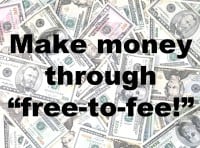
“FREE-TO-FEE” DRIVES NEW WIN-WIN MARKETS

Customers set the price as everything commoditizes
- Dateline
- 20 July 2016
Remember the bad old days when businesses, rather than we consumers, set the price of goods and services? Back before actual value-added determined what the market was prepared to pay?
Nowadays, of course, ‘things’ are essentially free. Anyone selling anything needs to prove the value they bring – and then, in instant, ongoing, real-time electronic transactions, agree with the user just what that value is worth.
The revolution started in many different ways. The concept of “Googlenomics” emerged – a new economic model of giving away the commodity (like internet search) and charging for on-top value-added; in Google’s case, selling advertising for which marketers were prepared to pay.
Other businesses were quick to spot the power of building markets through ‘Free-to-Fee.’
Open-source code popped up everywhere. New-age media houses gave their content away; instead becoming part of the transactional chain. Musicians released their music free, and made money from concerts and merchandising.
Rolls-Royce gave away its jet engines at no charge, in exchange for large ongoing maintenance contracts. And then the financial crisis of 2008 forced every business to sharpen its prices just to survive, and to show value. So the revolution spread.
By 2011 it was mainstream, with drug companies, health care and other services industries being paid only if their services delivered what they promised.
And today, all commoditized products and services are free, and there’s very little in the market that is not priced by being directly linked to the customer’s perception of value.
Who says the Internet didn’t change everything?
ANALYSIS >> SYNTHESIS: How this scenario came to be
1983: Free software movement launches
The free software movement, which argues that software and other copyrighted material, such as music, literature, photography and so on, ought to reside in the public domain, launches this year. A fascinating new debate starts around the concept that intellectual property should be free, giving rise to global movements like Copyleft.
1998: Microsoft challenged
In 1998 use of the phrase ‘Open source software’ becomes widespread, as programmers, individuals and lobby groups challenge Microsoft’s growing monopoly on computer operating systems and programs. Companies like Netscape make bold stands by releasing source code for their applications without charge.
Napster challenges the music industry by giving away music free, provoking major lawsuits. But new sites like LimeWire and BitTorrent sidestep this through peer-to-peer computing.
But the law pursues Microsoft. As the Windows operating system continues to dominate the world, a number of competitors, countries and regions turn to the courts seeking to break Redmond’s strangle-hold on the lucrative software market.
2003: The Google Giant stirs
Google is now set to become the dominant force in Internet search. And free has become the order of the day, with Google (and others) giving away their core products – such as search – for free, while employing sophisticated algorithms to participate in the transactional chain at points where users perceive value, and are prepared to pay for it.
The age of ‘Googlenomics’ has arrived, and hundreds of businesses start building markets by embracing the ‘Free-to-Fee’ model.
2008: Free goes mainstream
The Internet democratized information. Pure knowledge alone is no longer power, with anyone being able to search and find almost anything.
But as Internet 2.0 emerges, many other components of the market start to commoditize, from the infrastructure on which the network runs, to services and even products.
Health agencies in the UK enter into a ground-breaking agreement with a manufacturer of cancer drugs, in terms of which the manufacturer gets paid only if the treatment works. The scene is set for a new ‘paid-by-results’ economic system.
Then in late 2008, the global financial crisis hits. Companies around the world are forced to cut prices just to stay in business. Old businesses seek new business models, and the ‘Free to Fee’ idea spreads.
2014: The consumer is in charge
Increasingly, customers determine the real value of products and services. Transparent and ubiquitous competition drives businesses to actively demonstrate the value they add – and those that can’t show value go out of business. The old days of simply charging a price for a product are numbered. Advanced networking enables instant and automatic pricing markets to develop, much like real-time stock markets, to fairly determine and agree value between buyer and seller on the fly.
2016: The customer really IS king
Decades after the phrase “the customer is king” was coined, it has finally come to fruition. And it’s been driven by the era of openness, transparency and interconnectivity. The sweeping claim of the dot.com boom, that “The Internet changes everything”, is finally coming true.
Links to related stories
- Pay-by-results pricing opens up better cancer drugs - New Scientist, 1 December 2007
- Googlenomics - one of the first discussions, from Blog Maverick, 2006
- MindBullet: RECORD SALES PLUMMET AS MUSIC BOOMS (Dateline: 1 June 2011, Published: 22 November 2007)
- MindBullet: FREE COMPUTERS FOR ALL (Dateline: 14 June 2012, Published: 12 August 2004)
- MindBullet: THE #1 CLOUD BANK OPENS ITS DOORS (Dateline: 11 June 2013, Published: 13 November 2008)
Warning: Hazardous thinking at work
Despite appearances to the contrary, Futureworld cannot and does not predict the future. Our Mindbullets scenarios are fictitious and designed purely to explore possible futures, challenge and stimulate strategic thinking. Use these at your own risk. Any reference to actual people, entities or events is entirely allegorical. Copyright Futureworld International Limited. Reproduction or distribution permitted only with recognition of Copyright and the inclusion of this disclaimer.